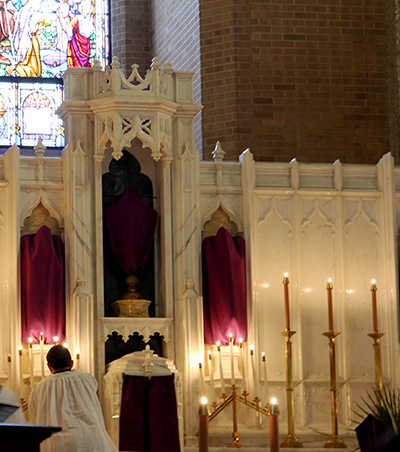 GREENSBORO — A sorrowful yet beautiful Tenebrae service at Our Lady of Grace Church ended in total darkness and silence after the last word was chanted and the last light, one lit candle, was hidden – leaving parishioners feeling the weight of Jesus’ crucifixion and death.
GREENSBORO — A sorrowful yet beautiful Tenebrae service at Our Lady of Grace Church ended in total darkness and silence after the last word was chanted and the last light, one lit candle, was hidden – leaving parishioners feeling the weight of Jesus’ crucifixion and death.
The service, held on the evening of April 16 – sometimes called "Spy Wednesday," by tradition the day when Judas agreed to betray Jesus – featured Gregorian chants and powerful music, thanks to the parish's new sacred music director, Dr. Jarred Tafaro.
“There is a lot of music written for Tenebrae,” Tafaro said. “It inspires people, and there is just so much that can happen musically.”
Tenebrae means “darkness” or “shadows” in Latin. The two-and-a-half hour Tenebrae service featured readings from Lamentations and the Gospels that recall the destruction of the Temple in Jerusalem, and that of the living temple, Jesus Christ.
The mystery and somberness of the traditional liturgy is becoming more popular at parishes across the Diocese of Charlotte, including at Our Lady of Grace.
 Tafaro, who came to the parish in October from The Catholic University of America in Washington, D.C., and his 35 choir members practiced the program almost nightly for months.
Tafaro, who came to the parish in October from The Catholic University of America in Washington, D.C., and his 35 choir members practiced the program almost nightly for months.
“The choir – it’s like there is something extra when they sing. It is hard to explain,” said parishioner Michael Long. “I think it is because they are so serious, they work so hard and they are all very prayerful people, and I am so happy they sing so well.”
Candlelight and soft melodies from violinist Vivian D’Amelio were the perfect prelude to the otherwise solemn service. A fitting composition called “The Angel,” in honor of the angel who accompanied Christ during His abandonment in the Garden of Gethsemane, was followed by a silent procession led by pastor Father Casey Coleman, other clergy, seminarians and altar servers.
Around 300 parishioners knelt before a purple cloth-covered crucifix and a tabernacle surrounded by 15 lit candles in two golden candleholders called hearses. These candles were slowly snuffed out – one by one – as parishioners were guided through a recounting of the destruction of Jerusalem, the Last Supper, Jesus' Agony in the Garden, His Passion and Death, and His placement in the tomb.
The church’s Gothic architecture with its vaulted ribbed ceilings, arched brick walls, wooden choir lofts, and large stained-glass windows provided a perfect backdrop for the angelic voices of the choir, who chanted Renaissance-era pieces from Josquin des Prez, Tomás Luis de Victoria, and Cristóbal de Morales. Dr. Tafaro wrote his own composition, “Crying,” which the choir performed after the reading about Judas’ betrayal.
As parishioners prayed, the choir – wearing all black – moved behind the scenes, quickly repositioning themselves among the three choir lofts during song intermissions to add to the impact of the evening.
The climax of the program occurred when the last candle was removed by Father Coleman, leaving the sanctuary dark, quiet and grim. Suddenly, organ keys were hammered and books clashed together to create the “strepitous” – Latin for “racket,” mimicking the sounds of the earthquake after Christ’s death.
“The organ and clapping of our books are meant to be startling,” Tafaro explained.
Then the liturgy ended and worshippers departed in darkness – left to remember Jesus' Passion and death, and look forward to His Resurrection to come.
— Lisa Geraci


